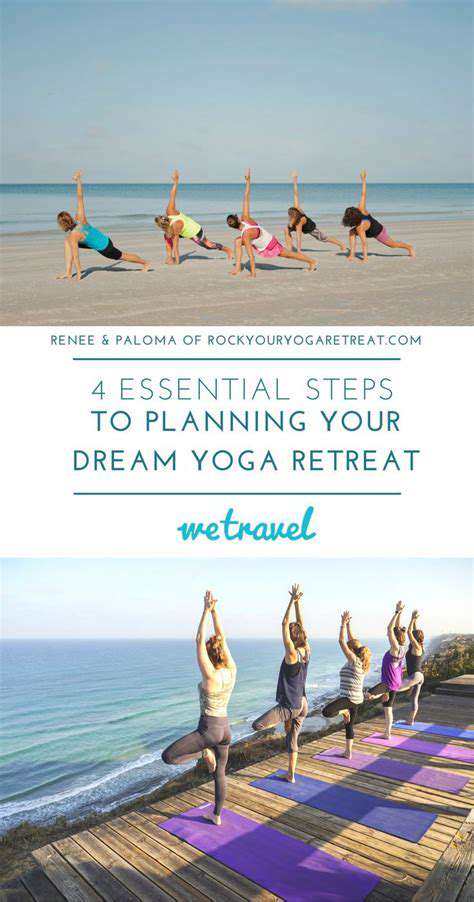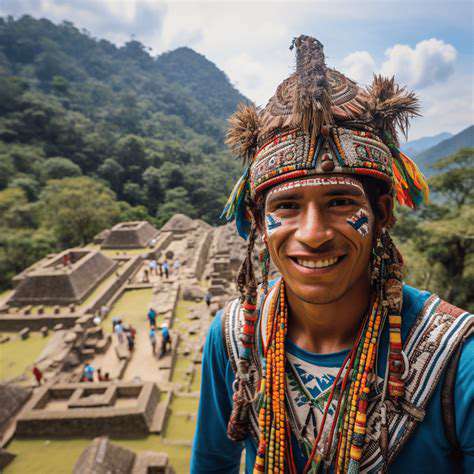Taking a Yoga Retreat Abroad

Choosing the Perfect Destination
One of the most important decisions when organizing your ideal yoga retreat is picking the perfect spot. The experience you crave should guide your choice. Do you long for a quiet mountain hideaway for profound self-reflection, a lively beachfront locale with energizing sea vistas, or a peaceful rural setting to commune with nature? Investigating various places and their distinctive features is crucial. You might read testimonials from past participants, examine nearby facilities, and evaluate the general atmosphere of potential retreat centers.
Reflect on the particular activities you want included in your retreat. Breathtaking natural surroundings can dramatically improve your entire journey. Are you imagining a calm space for complete unwinding or an energetic program centered on perfecting advanced postures? Knowing your preferences will steer your exploration, helping you discover a location that matches your expectations and aspirations.
Defining Your Retreat's Focus
Prior to making reservations, clearly establish the primary purpose of your yoga retreat. Is your goal a rejuvenating break, an intensive power yoga program, or a comprehensive wellness experience incorporating multiple disciplines?
Articulating your objectives precisely will lead you to select a retreat facility that resonates with your aims. This could mean identifying your preferred yoga style, your skill level, and any supplementary activities you desire, like meditation sessions, nutritious meal options, or consciousness-raising seminars.
Creating a Detailed Schedule
A well-structured timetable is fundamental for a rewarding yoga retreat. Think about including diverse elements such as yoga sessions, meditation periods, nature walks, or culinary demonstrations. This organization will keep you focused and help you gain maximum benefit. Remember to schedule ample downtime for personal contemplation and renewal.
Arranging specific meal times and optional activities is equally important. This foresight can eliminate unnecessary tension and guarantee you have sufficient opportunity to engage fully in all offerings. However, maintaining some flexibility in your plan is wise, as unexpected situations may occur.
Accommodation and Amenities
Choosing appropriate lodging is critical for your yoga retreat. Evaluate factors like accommodation style, privacy levels, and distance from the main retreat area. Verify that available facilities match your requirements. A serene and cozy setting is indispensable for a genuinely life-changing experience.
Investigate various lodging possibilities, including private suites, shared quarters, or even luxury camping. Determine which comfort features and services are vital for your wellbeing. This attention to detail will enable you to unwind completely and concentrate on the retreat's activities.
Budgeting and Booking
Establishing a practical budget is essential when planning your yoga retreat. Account for all potential expenditures including transportation, lodging, meals, and extra activities. Comprehensive preparation will prevent financial shocks during your retreat.
After setting your budget, investigate various retreat centers and compare their pricing. Reserve your spot early, particularly during busy periods, to ensure availability. Carefully review feedback and contrast different choices to make the optimal decision for your preferences and financial plan.
Crafting Your Retreat Itinerary: Beyond the Mat
Planning Your Pre-Retreat Activities
Before beginning your international yoga retreat, recognize the value of adequately preparing both mentally and physically. This preparatory phase is invaluable for establishing intentions, alleviating tension, and mentally transitioning from everyday responsibilities. Consider incorporating calming activities that will help you decompress and gradually attune to the focused practice ahead. Gentle nature walks or basic stretching routines could effectively prepare you physically and psychologically for the demanding yet rewarding experience awaiting you.
Additionally, utilize this time to study the retreat facility and surrounding region. Familiarizing yourself with the environment, class offerings, and local customs can help align your expectations and optimize your time abroad. This proactive strategy can substantially improve your overall experience.
Understanding Your Needs: Tailoring Your Retreat
Various yoga retreats serve different purposes and preferences. Some emphasize rigorous physical practice while others focus on mindfulness and meditation. Identify which yoga aspects resonate most with you. Are you seeking challenging physical routines, peaceful meditation spaces, or a balanced combination? Recognizing your personal requirements will help you choose a retreat that matches your objectives, ensuring a more satisfying experience.
Also contemplate your preferred pace and involvement level. Do you want a tightly scheduled program or greater flexibility and independence? A retreat customized to your specific needs will create a more personalized and meaningful journey, allowing complete immersion in the practice.
Beyond the Mat: Cultural Immersion
An international yoga retreat offers more than physical exercise; it's a chance to engage deeply with another culture. Discover the local area by visiting historical landmarks, exploring markets, or participating in cultural events. This immersion will enrich your experience while deepening your appreciation of the location and its inhabitants. Such active participation enables you to value the distinctive qualities of your destination.
Consider enrolling in cooking classes to learn regional dishes or joining guided tours to uncover hidden treasures. These activities will provide cultural insights and create enduring memories beyond yoga sessions.
Nutrition and Well-being: Fueling Your Journey
Diet significantly impacts your wellbeing during a yoga retreat. Investigate meal options at your chosen retreat center. If you have dietary limitations or preferences, confirm the facility can accommodate them. Understanding food availability will help plan your nutrition and ensure proper sustenance throughout your stay.
Additionally, view local cuisine as part of your cultural exploration. Embark on culinary adventures to sample regional flavors. Visit local markets and experiment with new dishes for a more comprehensive retreat experience. You might discover delightful new foods and eating approaches.
Post-Retreat Integration: Maintaining Momentum
Following a transformative yoga retreat, sustaining your progress is essential. Establish a consistent yoga routine to continue applying lessons and techniques learned during your retreat. Regular practice is crucial for preserving positive changes and incorporating new methods into daily life.
Schedule regular yoga sessions, meditation periods, or mindful activities into your weekly routine. This consistency helps maintain positive energy and preserves benefits gained during your retreat, ensuring long-term rewards after returning home.
Budgeting Your Yoga Adventure: Making it Affordable

Understanding Your Financial Needs
When beginning a yoga journey, comprehending financial requirements is vital. This includes initial investments like yoga mats and props, plus recurring costs such as class fees, workshops, and potential retreats. Precise budgeting prevents financial pressure and ensures uninterrupted practice enjoyment. Detailed budgeting helps monitor spending and identify potential savings areas.
Consider your practice frequency. Are you planning daily sessions, weekly classes, or irregular attendance? This frequency directly affects overall expenditures on classes and related activities. This awareness will shape your budgeting approach and ensure proper fund allocation.
Exploring Different Yoga Styles and Prices
Yoga offers numerous styles, each with unique characteristics and associated costs. For example, hot yoga typically costs more than traditional Hatha yoga. Similarly, specialized workshops or retreats for styles like Ashtanga or Iyengar may have varying prices. Researching different styles and their costs helps make informed decisions aligning with your budget.
Comparing prices across various studios or instructors is equally important. Contact multiple studios to understand their pricing models. This research provides a solid foundation for your budgeting process.
Essential Yoga Equipment: Cost and Alternatives
While yoga mats, blocks, and straps are standard for many practitioners, prices vary widely. Consider economical alternatives like using towels or sturdy blankets instead of yoga mats. Finding affordable options can substantially reduce initial practice investments.
Try borrowing or renting equipment initially to assess necessity. This practical approach determines if specific gear is truly needed or can be temporarily omitted. This method saves money without compromising your practice.
Creating a Realistic Yoga Budget
Develop a practical yoga budget accounting for all potential expenses, including classes, equipment, workshops, and possible retreat travel costs. Be thorough in budgeting, anticipating unexpected costs.
Categorize expenses for easier tracking. This helps understand spending patterns and identify potential savings areas.
Saving Money on Yoga Classes and Workshops
Explore various cost-saving options for classes and workshops. Look for introductory offers, discounts, or group packages reducing overall expenses. Utilize student or senior discounts when applicable. Attend trial classes before committing to long-term memberships.
Research free or low-cost community classes in your area. Many organizations offer affordable introductory yoga sessions. Exploring these resources expands options while aligning practice with your budget.
Tracking Your Progress and Adjusting Your Budget
Regularly monitor yoga spending and adjust budgets accordingly. As your practice evolves, needs may change, requiring budget modifications. This could mean increasing allocations for advanced classes or reducing them for home-based practice. Periodically evaluate progress and adjust budgets. Ensure budget flexibility accommodates future yoga aspirations.
Account for unexpected costs like new equipment or specialized workshops. Budget buffers provide greater flexibility and peace of mind.
Embracing the Journey: Preparing for Your Yoga Retreat
Choosing the Right Retreat
Selecting an ideal yoga retreat is fundamental for a fulfilling experience. Identify your preferred yoga style - whether intensive Ashtanga, gentle restorative practices, or blended approaches. Research instructors' qualifications to ensure alignment with your goals. Consider location carefully; beautiful natural settings significantly enhance practice immersion. Evaluate overall atmosphere; community-focused retreats may appeal if seeking connections with fellow practitioners.
Consider factors like duration, accommodation type, and included activities. Longer retreats allow deeper exploration while shorter ones serve as good introductions. Decide between luxury experiences with spa services or budget-friendly options emphasizing practice. Thorough research helps identify retreats matching your needs, creating truly enriching experiences.
Preparing Your Body and Mind
Physical preparation ensures enjoyable retreat experiences. Gradually increase daily movement beforehand. Gentle stretches and light cardio build stamina and flexibility. Listen to your body, especially with pre-existing conditions. Proper hydration and nutrition are essential. Consume balanced diets rich in fruits, vegetables, and whole grains to fuel your practice.
Mental preparation is equally crucial. Cultivate mindfulness and acceptance. Release expectations and approach the journey openly. Visualize practicing yoga in serene settings among supportive individuals. This visualization fosters positive mindsets for transformative experiences.
Packing for Success
Pack lightly for yoga retreats. Prioritize comfortable, breathable yoga clothing and multiple workout outfits. Include essentials like yoga mats, props (blocks, straps, blankets), and comfortable shoes. Remember toiletries, sunscreen, and regular medications. Most importantly, bring openness and willingness to embrace the experience.
Pack essentials only. Include hygiene products, personal care items, and relaxation aids. Consider journals for documenting experiences or cameras for capturing scenery. Remember travel documents for international trips. Advance planning ensures smooth journeys, allowing focus on practice and experience.
Embracing the Culture
Many retreats are located in culturally rich areas. Cultural immersion significantly enhances experiences. Learn basic local phrases. Explore markets, sample regional cuisine, and interact with locals. Visiting historical sites and experiencing local traditions deepens destination appreciation.
Respect local customs and traditions. Learn regional norms and etiquette. Engage thoughtfully and respectfully with communities. This fosters global understanding and meaningful connections. Ultimately, cultural engagement makes yoga retreats unforgettable and enriching.

![How to Travel on Points and Miles [Travel Hacking]](/static/images/27/2025-05/StayingUpdatedontheLatestTravelHackingTrendsandOpportunities.jpg)





![Taking a Pottery Workshop in Morocco [Cultural Experience]](/static/images/27/2025-05/BeyondtheWorkshop3AConnectingwiththeLocalCommunity.jpg)



